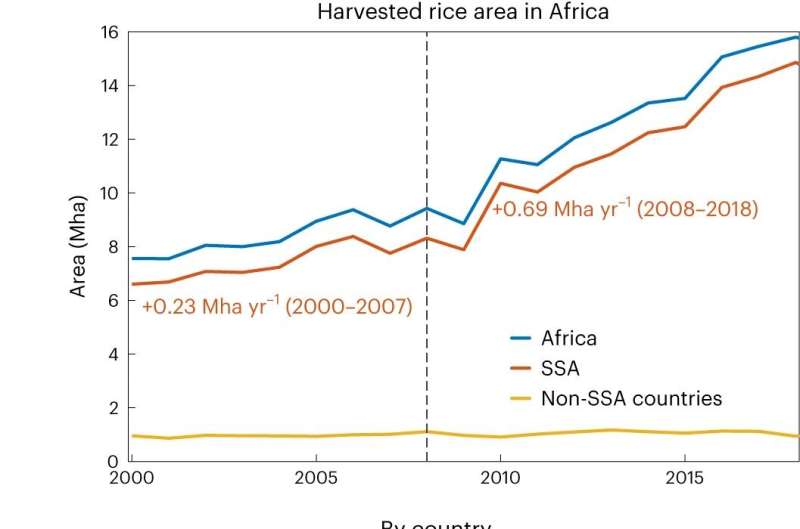January 5, 2024 report
This article has been reviewed according to Science X's editorial process and policies. Editors have highlighted the following attributes while ensuring the content's credibility:
fact-checked
peer-reviewed publication
trusted source
proofread
Increase in rice farming in sub-Saharan Africa found to be producing rising amounts of methane

A team of engineers and atmospheric scientists at Harvard University, working with a colleague from the California Institute of Technology's Jet Propulsion Laboratory, has calculated the increased amount of methane being expelled into the atmosphere due to increases in rice farming in parts of Africa.
In their paper published in the journal Nature Climate Change, the group describes how they recalculated methane emissions due to recent increases in rice production in sub-Saharan Africa, and what they found by doing so.
Prior research has shown that methane is the second most important greenhouse gas (behind carbon dioxide)—it has been found to have more radiative properties (it holds in heat better) than CO2, which means that even though far less of it is emitted into the atmosphere, it still plays a major role in global warming.
Prior research has shown that agriculture activities (from crops and livestock combined) account for approximately 25% of all human-caused methane emissions into the atmosphere. Waste disposal and fossil fuel production account for most of the rest.
Prior research has also shown that growing rice in sub-Saharan Africa doubled in production from 2008 to 2018—a good trend for feeding people (it currently accounts for approximately 9% of the continent's caloric intake) but not so good for the environment. Growing rice releases very large amounts of methane into the atmosphere.
In this new effort, the researchers started with numbers representing Africa's total greenhouse gas emissions prior to 2008 and then added in the amount that has been emitted due to factors involved in growing rice, such as irrigating, flooding patties, burning fields, and harvesting.
As part of that effort, they assessed the rice-growing extent, which included more accurately outlining rice-growing land and the number of days rice fields in Africa emit methane. They then used what they had learned to calculate new estimates of methane emissions into the atmosphere for all of Africa.
The research team found that the increase in rice production in Africa accounted for approximately 31% of the increases in methane emissions for all of Africa from 2006 to 2017, and 7% of the global rise in methane emissions for the same period.
More information: Zichong Chen et al, African rice cultivation linked to rising methane, Nature Climate Change (2024). DOI: 10.1038/s41558-023-01907-x
Journal information: Nature Climate Change
© 2024 Science X Network




















